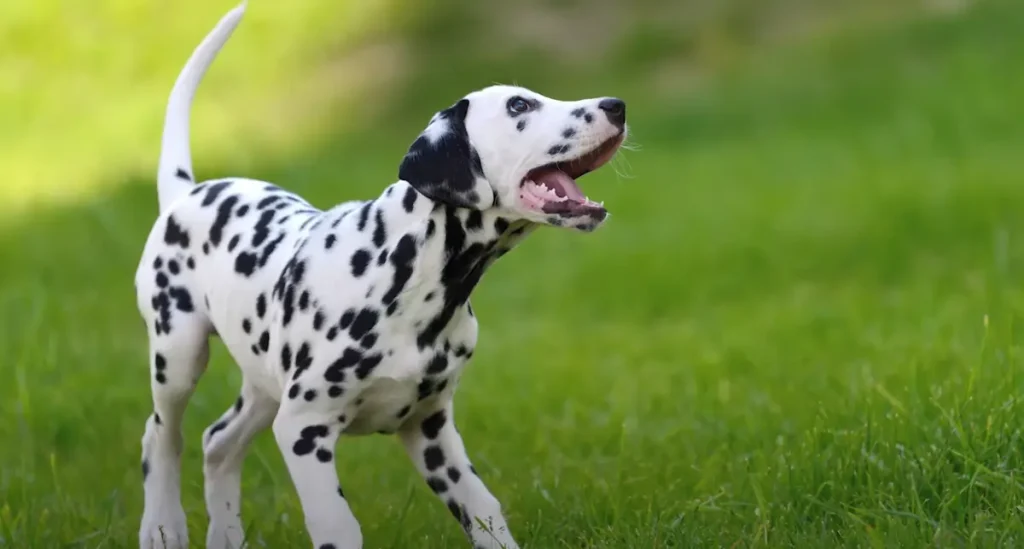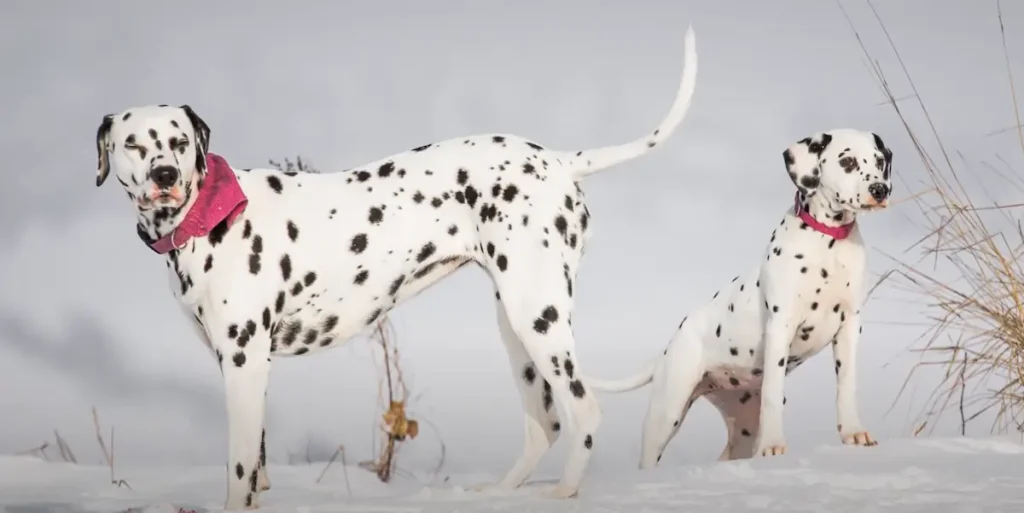As a chessboard is to a grandmaster, so is the coat of a Dalmatian to the canine world: distinctive, strategically patterned, and impossible to ignore. You’ve likely seen their spots, as unique as fingerprints, and maybe you’ve been charmed by their energetic and playful disposition.
Yet, beneath the surface of their spotted coats lies a complexity of traits and temperament that beckons your understanding. These dogs are more than just their iconic appearance; they’re a breed with a rich history and a set of needs that demand an informed and dedicated caretaker.
As you contemplate welcoming a Dalmatian into your life, it’s crucial to consider whether their boundless energy and specific care requirements align with your lifestyle. What you discover about their character and the care they need may surprise you, and it’s this journey of discovery that will ultimately guide you to make the right decision about bringing a Dalmatian into your home.
Dalmatian: Traits, Temperament, and Care Guide
The Dalmatian’s distinctive spotted coat and robust physique are reflections of its historical role as a multi-purpose working breed. This history means that the Dalmatian requires a tailored approach to its care, training, and exercise needs to maintain its optimal health and behavior.
Your Dalmatian breed thrives on positive reinforcement. This means that training and interacting with your Dalmatian should focus on rewarding good behavior and using positive reinforcement techniques. This approach caters to the Dalmatian’s playful temperament and helps to reinforce a strong bond between you and your pet.
It’s also important to be vigilant of potential health issues that are common in Dalmatians. One of the most well-known health issues in the breed is hearing loss. Regular check-ups with a veterinarian can help to identify and address any potential health concerns early on.
In terms of exercise, Dalmatians have innate exercise needs that should be fulfilled regularly. Providing your Dalmatian with diverse forms of exercise, such as walks, runs, and playtime, can help to keep them physically and mentally stimulated.
Exploring the Characteristics of the Dalmatian
Building on the understanding of the Dalmatian’s care and training needs, let’s examine the breed’s distinct characteristics, including its history, physical attributes, and behavioral tendencies.
| History | Physical Attributes | Behavioral Tendencies |
|---|---|---|
| Coach dog | Spotted coat | Moderately easy to train |
| Running alongside horse-drawn vehicles | 19-24 inches in height | Playful and affectionate |
| Fire department mascot | 45-70 pounds in weight | Alert watchdog |
As spotted dogs with a rich history, Dalmatians require a specific lifestyle to thrive.
Dalmatian: A Comprehensive Profile and Guide
To ensure the well-being of the Dalmatian breed and cater to its distinctive needs, you need a detailed understanding of the breed.
Assessing their genetic history, you’ll recognize that their spotted coat isn’t merely decorative but a result of a complex interplay of genes.
Their requirement for regular exercise stems from a high metabolic rate and an inherent need for mental stimulation, which if unmet, can lead to behavioral issues.
Everything You Need to Know
Delving into the world of Dalmatians offers insight into a breed distinguished not only by its iconic spotted coat but also by its multifaceted history and versatile abilities.
Dalmatians: A Comprehensive Profile
- Historical Roles:
- History as carriage dogs
- Mascots for fire departments
- Health and Care:
- Need plenty of exercise
- Prone to deafness; uric acid concerns addressed by the Kennel Club
Discovering the Temperament
Exploring the temperament of Dalmatians reveals a breed characterized by a warm, affectionate demeanor, particularly evident in their interactions with family members. These spotted coat companions are highly intelligent, showcasing a robust sense of humor.
Dalmatians’ genetic mutations not only define their unique appearance but also contribute to their distinct personality. They need plenty of exercise and thrive in environments that challenge their minds and bodies.

Dalmatian: Is It a Good Fit for Families?
You might wonder if a Dalmatian’s energetic and playful nature suits a family setting, especially with kids. Consider the breed’s need for patient training and consistent exercise to determine if your lifestyle can accommodate these requirements.
Furthermore, it’s crucial to evaluate the implications of potential health issues, such as deafness and urinary problems, on long-term care responsibilities within a family context.
Assessing Dalmatian’s Compatibility with Families and Kids
When assessing the Dalmatian’s compatibility with families and kids, it’s crucial to consider their energetic disposition and how it aligns with the dynamics of a household, especially one with children.
- Active Households:
- Thrive with Dalmatian puppies that need plenty of exercise
- Align well with Dalmatians’ desire for attention wherever they go
- Young Children:
- May find Dalmatian puppies boisterous
- Need supervision to ensure they get along well
Dalmatian Climate Flexibility
Known for their striking spotted coats, Dalmatians also exhibit remarkable adaptability to various climates, tolerating high temperatures with relative ease. Their short coats facilitate thermoregulation, yet they need plenty of fresh water and shade to prevent overheating.
Ensure they get enough exercise appropriate for their high energy levels to maintain their generally healthy status. With proper care, these agile dogs integrate seamlessly into diverse environmental conditions.
Dalmatian Obedience Essentials
You’ll find that your Dalmatian’s moderate trainability requires you to employ consistent and patient training methods.
To mitigate their tendency for short attention spans, they integrate varied stimuli and rewards into their training routines.
It’s critical to start training early, focusing on obedience to ensure they develop into well-behaved adults.
Effective Training Strategies
To effectively train a Dalmatian, it’s crucial to employ consistent, patient, and positive reinforcement-based strategies that align with the breed’s active nature and intelligence.
| Strategy | Benefit | Consideration |
|---|---|---|
| Consistent Reinforcement | Fosters reliable obedience | Avoid confusion and ensure clear boundaries |
| Positive Reinforcement | Enhances learning, uses praise or treats | Align with brainstem auditory evoked response |
| Early Socialization | Prevents timidity, promotes sociability | Important to note for temperament shaping |
Make sure your Dalmatian’s training is as dynamic as their history running alongside carriages. Puppies are born learners, so start early. Remember, they shed a lot, so grooming can be part of routine bonding.
Exercise and Grooming Needs
Dalmatians typically require substantial exercise due to their historical role as carriage runners, necessitating activities like daily jogs or hikes to maintain their physical and mental well-being.
Bred to run alongside carriages and later, fire trucks, they thrive on Road Trials and bike rides.
Their exercise and grooming needs are moderate; a short white coat with iconic spots demands weekly brushing, reflecting their active, yet manageable, lifestyle.

Health Considerations
As you consider adding a Dalmatian to your family, it’s essential to be aware of their specific health challenges.
You’ll need to monitor their hearing closely, as a significant percentage suffer from varying degrees of deafness.
Additionally, their unique metabolism makes them susceptible to urinary stones, necessitating a carefully tailored diet and regular veterinary screenings for early detection and management of this and other conditions such as thyroid disease and skin problems.
Common Health Issues and Lifespan
With an average lifespan ranging from 11 to 13 years, Dalmatians often face health challenges such as deafness and urinary system issues due to genetic predispositions. Up to 30% of Dalmatians experience some degree of hearing loss.
Their short white coat, while distinctive, doesn’t indicate a natural affinity for good health. A diet low in purines is crucial, as they’re prone to kidney stones, necessitating vigilant care and regular veterinary oversight.
Alternatives for Dalmatian: Energetic and Eye-Catching Breeds
For those captivated by the Dalmatian’s energy and distinctive coat, here are similar breeds that offer a blend of liveliness and unique appearances.
| Similar Dogs | Short Description |
|---|---|
| Pointer | A breed known for its athletic build and enthusiasm for hunting. |
| Weimaraner | Known for its striking appearance and proficiency in various types of hunting. |
| English Setter | Elegant and gentle, adept at bird hunting and known for its friendly temperament. |
| Vizsla | A Hungarian breed famous for its hunting skills and affectionate nature. |
| Rhodesian Ridgeback | Known for the distinctive ridge on its back and its versatility as a hunter and family pet. |
Is Dalmatian the Right Pet for You?
Considering the Dalmatian’s high energy levels and specific health concerns, you should assess whether your lifestyle and home environment can accommodate one’s needs before deciding to welcome one into your family.
The Dalmatian’s temperament demands active engagement, and its spotted coat, best known from the Disney film ‘101 Dalmatians,’ requires regular grooming.
They shouldn’t be left alone for long and typically get along well with other pets.
Conclusion
In the symphony of breeds, the Dalmatian is the percussionist—vibrant, rhythmic, and impossible to ignore. Your commitment to their training and exercise resonates with the health and harmony of your spotted companion.
Just as a conductor’s baton directs an orchestra, your guidance shapes their exuberant energy into a protective, playful member of your household ensemble. Choose a Dalmatian, and you’re not just adopting a pet; you’re embracing a lifestyle that’s as dynamic as their distinctive coat.
Frequently Asked Questions
What Is the Temper of a Dalmatian?
You’re dealing with an energetic companion when you choose a Dalmatian. Their intelligence demands consistent training to prevent separation anxiety. Regular exercise curbs potential destructive behavior, while early socialization is key for their guarding tendencies.
What Is the Personality of a Spotted Dog?
You’re exploring spotted psychology, where playful energy meets guarding instincts. Within family dynamics, they require frequent exercise, their intelligence quirks demand patient social interactions, fostering a sense of belonging among those who understand their spirited nature.
Why Are Dalmatians Spotty?
You see those spots because genetic origins affect pigment cells. Coat genetics, influenced by historical theories and breeding practices, dictate spot distribution. It’s a mutation effect, not just random chance, that creates their unique pattern.
How Cuddly Are Dalmatians?
You’ll find Dalmatians offer abundant companionship warmth, craving affectionate interactions. They adore playful snuggles and seek out gentle hugs, reflecting their petting preferences. These cozy moments are vital for their bonding process.
